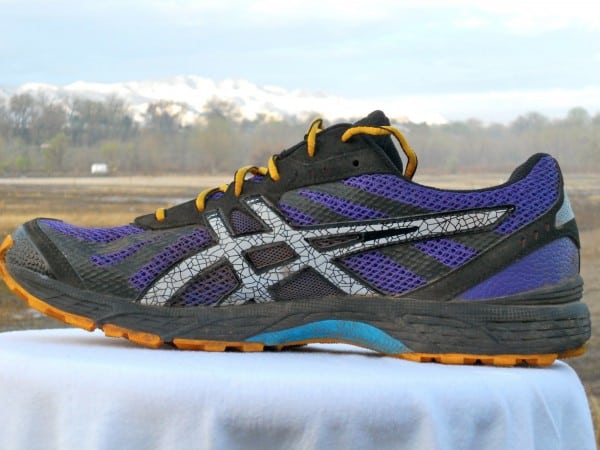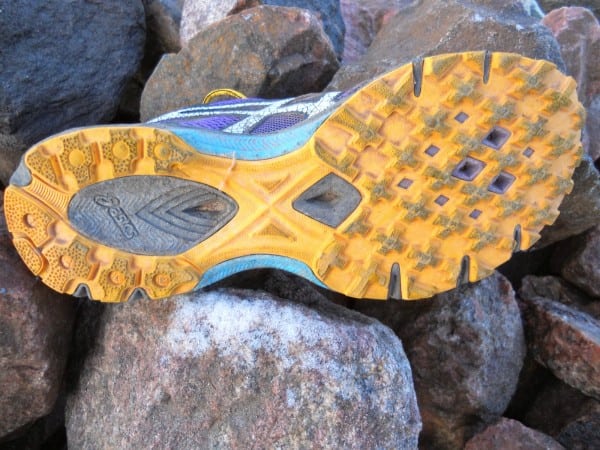Our Favorite Trail Running Shoes
Check out our Best Trail Running Shoes article to learn about our current favorite trail running shoes!
Asics Gel Fuji Racer Review
There is a fine line between trail shoes marketed as minimalist that are functional and protective enough to run an ultra, and those that seem to be either training tools or passing fads. As someone who enjoys minimalist footwear, there are quite a few shoes I get to review that I would not put on for anything over ten miles on mellow trail. Needless to say, it is always rewarding when a new trail shoe comes along and seems to inhabit that magical niche that has me feeling like I can wear it for a long day on the trails and not come home with beat up feet.
I have to admit, I’ve never been impressed with Asics trail shoe offerings, until now. The Fuji Racer ($110) is their first trail shoe offering weighing in under 10 ounces (8.8 oz) with a fit and feel that is reminiscent of Asic’s very popular racing flats.
Upper
One of my favorite aspects of any Asics shoe is the fit and last, which seems to be largely consistent throughout their line. Fans of Asics road shoes will be pleased that the fit of the Fuji Racer maintains that feeling of a snug heel that widens into an accommodating forefoot. A breathable dual-density mesh supported by traditional, sewn-on overlays provides a simple and effective upper that drained well on wet runs during my testing. Well-placed welded overlays reinforce the upper over areas of high wear on the outside of the toe box and a reinforced toe rand offers some protection from toe stubbing rocks.
The lacing system is traditional with the appreciated addition of skinny oval laces that stay tied wonderfully well while feeling very snug and secure throughout the midfoot. Curiously, the tongue features a lace garage which is well designed, but superfluous. Compared to other Asics shoes I own, the 9.5D I tested in the Fuji Racer runs true to size but the fit is snug, more like a racing flat. This didn’t bother me much, but I accommodated the tighter fit throughout the midfoot and heel by wearing very thin running socks.
Midsole
Asics utilizes a full-length Solyte EVA foam throughout the Fuji Racer to give the shoe a firm, yet very nimble and responsive ride. Again, comparisons to a racing flat come to mind, but the difference is that this layer of foam provides adequate protection for all but the burliest of rocky trails. A thin rock plate offers some protection but doesn’t seem to decrease the high level of flexibility in the forefoot, which was appreciated on cambered trails and uneven ground.
Asics put a Gel cushioning unit in the heel wasn’t especially noticeable other than the Fuji Racer handled steep downhills exceptionally well without leaving me feeling vulnerable to sharp rocks or beat up feet. A torsion control Trusstic System is placed in the midfoot and is usually exposed on Asics shoes. It was very appreciated that this thermoplastic unit is covered by the outsole rubber and in my opinion this torsion system is pretty minimal compared to those found on most Asics trainers. Some support is offered by this Trusstic System as the supportive plastic extends to the medial and lateral sides of the outsole. I think that slight overpronators could get away with this shoe for training and the Fuji Racer could really be enjoyed by any foot type for shorter distance trail racing.
Outsole
Asics High Abrasion Rubber (AHAR) is featured throughout the full length of the shoe and a simple, yet effective, lug design adds a good deal of traction. These X-shaped lugs feature a small rubber nub in the middle which is still present after 200+ trail miles. Noticeable diamond shape cutouts in the forefoot and midfoot of the outsole go through all the way to the footbed underneath the insole to increase drainage. To aid in this, the footbed underneath the insole is made of light mesh and the insole itself is perforated. These features were effective and the Fuji Racer seemed to dry out very quickly after splashing through creeks or slushy snow. I also appreciated that the shoe was always dry the next morning after a particularly wet run.
Overall Impressions and Performance
I don’t want to give you the impression that the Fuji Racer is a minimal shoe. Asics certainly didn’t just take a popular racing flat and glue on a rugged outsole. The Fuji Racer is an 9 oz, 6 mm drop agile and well fitting trail shoe. Not to mention its durability. Typically, I look for wear signs such as snags in the upper, outsole abrasion, and wrinkles in the midsole EVA after 100 miles or so on rough trail. My Fuji Racers are right at 200 miles and this shoe looks like its been out for only a couple runs.
The question is how well the Fuji Racer will protect you over the ultra distance. This is a shoe that would be first in my lineup for up to 50k, but I would hesitate to wear it past that distance personally. However, runners who can wear a shoe like the New Balance MT110 will find similar protection in the Fuji Racer. Where I feel that the Fuji Racer excels is on long ascents where its light weight and effective traction were very appreciated, and technical trails requiring a lot of careful foot placement and rock hopping.
Whatever your taste in trail shoes, the Fuji Racer is one of the most exciting and simply designed trail shoes I have gotten to try for 2012, and a legitimate lightweight trail runner/racer from Asics.
Call for Comments (from Bryon)
Have you run in the Asics Fuji Racer? If so, what do you think?
Ps. Thank’s to Running Warehouse for providing the Fuji Racers for testing!



